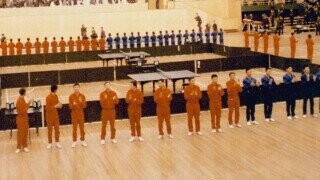When Ping-Pong Helped Improve U.S./China Relations

After the Chinese Revolution concluded in 1949, relations between the United States and the now-communist People’s Republic of China were essentially nonexistent. For more than two decades, until Richard Nixon visited the country in 1972, the two countries had no diplomatic ties. In the year before Nixon’s visit, though, signs of improving relations did appear, and we can thank the game of ping-pong for that.
Yes, in April 1971, nine members of the United States table tennis team were allowed to make the trip into China for a series of exhibition matches with the Chinese team. This event became known as “ping-pong diplomacy,” and these unwitting diplomats helped to play a major role in the changing political landscape of the Cold War.
Don't Miss
Ping-pong diplomacy began at the 1971 World Table Tennis Championships in Nagoya, Japan. In a rare feel-good moment of the Cold War, an American player named Glenn Cowan shared a friendly, appropriately diplomatic moment with Chinese player Zhuang Zedong. Cowan had missed a shuttle with the American team, so he hopped on the Chinese team’s shuttle instead. Zedong shook Cowan’s hand, and the two had a pleasant conversation. He even gifted Cowan a cloth that depicted China’s Huangshan mountains.

When the tournament came to an end, after the encounter between Cowan and Zedong had been publicized, Chairman Mao invited the American team, along with their spouses and a few journalists, to come to China. Americans were not allowed to visit China at this time, and American passports explicitly stated that they could not be used to travel to any communist country. However, it was clear that this was the start of something important, and so the ping-pong team was allowed to accept the invitation. Their passports were given official edits from the Department of State: China was crossed out on the list of countries that couldn’t be visited.
The American team flew to Hong Kong, which was then controlled by the British, and they then crossed a bridge into mainland China, becoming the first Americans to officially visit since 1949. Once they were at their destination, the ping-pong team did what they did best: play table tennis.
Exhibitions were held in a few cities in China. The Chinese team was leagues better at table tennis than their opponents, but the matches were not intended to be competitive. Instead, the point was to emphasize friendship between the two countries. During the weeklong visit, the Americans did not just play table tennis, though. They truly served as makeshift diplomats, touring Chinese landmarks and experiencing cultural activities and performances. They have had banquets with top Chinese officials, including Premier Zhou Enlai.

Now, as great as ping-pong diplomacy was, there are skeptics about just how spur-of-the-moment it all was. At this point in history, both the United States and China were hoping to get past the diplomatic hurdles between them. Nixon wanted to open relations with China. Meanwhile, China found itself at a crossroads. Relations had gotten worse with the Soviet Union, their one-time ally, and even though they were politically quite different from the United States, having this shared enemy gave the two sides a reason to be diplomatic. The ping-pong exhibition served as a catalyst to these greater aspirations.
Regardless of any plotting behind the scenes, though, the two ping-pong teams genuinely fell into their roles by accident. Glenn Cowan and Zhuang Zedong’s bus encounter at the World Championships was not the result of some Cold War under-the-table political deal. It was two guys from vastly different worlds meeting up and bonding over a shared interest: ping-pong.
Oh, and if an American playing ping-pong in China sounds familiar, yes, that part of Forrest Gump was based on the events of 1971.
Top Image: Richard Nixon Presidential Library and Museum/Wiki Commons